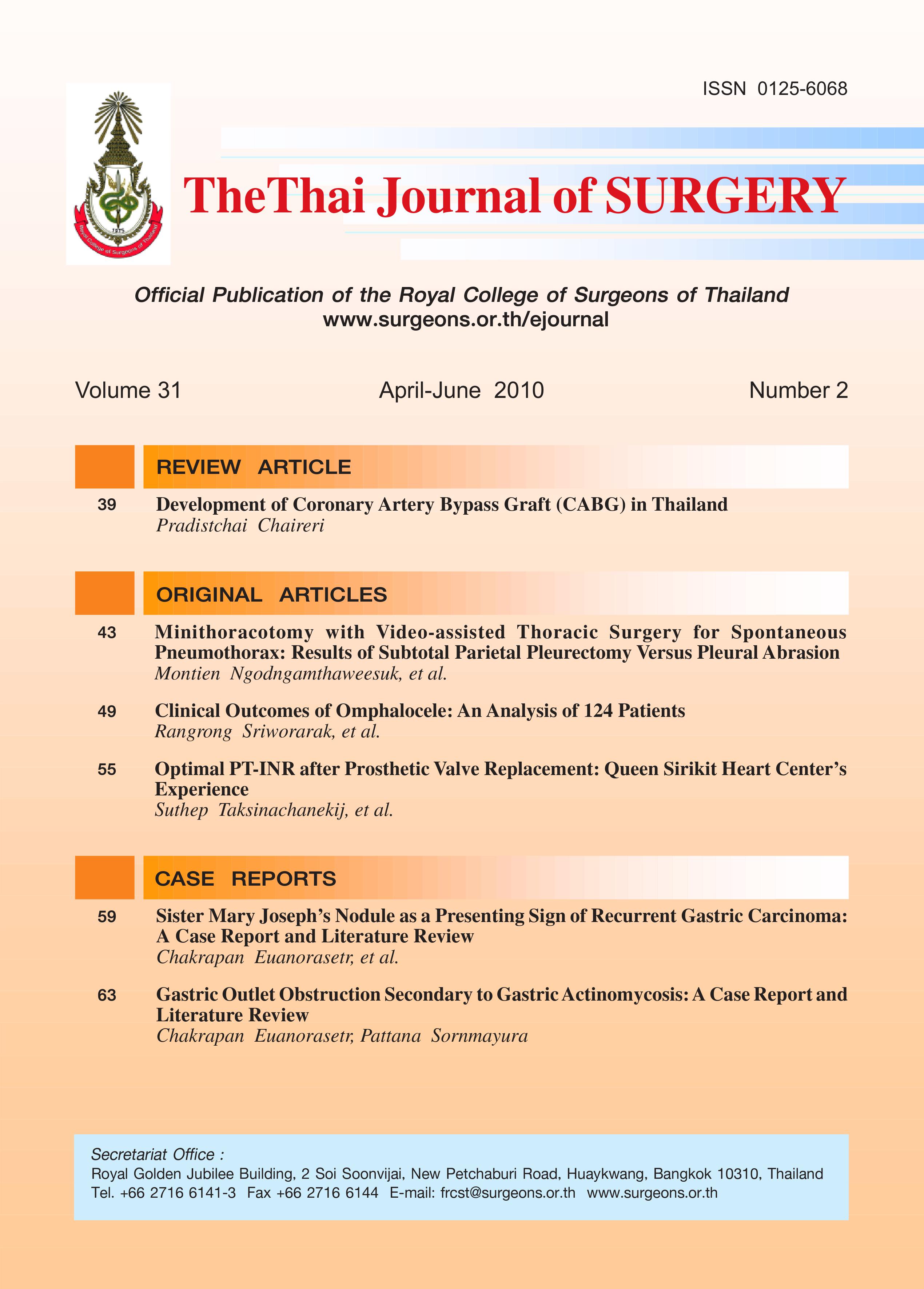Optimal PT-INR after Prosthetic Valve Replacement: Queen Sirikit Heart Center’s Experience
Keywords:
anticoagulant, prosthetic valve replacement, PT-INR, warfarinAbstract
Background: Anticoagulant therapy after valve replacement using mechanical valve is indispensible forprevention of thromboembolism. On the other hand, hemorrhagic complications due to overdosed
anticoagulations also deteriorate the patients.
Objectives: The purpose of this study was to investigate the PT-INR value of the patients who underwent
mechanical valve replacement with anticoagulant-related complications compared with those who had no
complications. In addition, we aimed to identify the optimal PT-INR value not leading to either hemorrhagic
or thromboembolic complications.
Materials and Methods: From September 2007 to April 2008, a total of 432 patients who underwent
mechanical valve replacement with 962 postoperative follow-up visits were investigated for the PT-INR values
and anticoagulant-related complications. The patients were divided into 3 groups: Group I had no complication,
Group II had bleeding complications either minor (i.e. gingival bleeding, small subcutaneous ecchymosis or
minimal hematuria) or major (i.e. cerebral hemorrhage and large hematoma requiring surgical drainage), and
Group III had thromboembolic complications. In addition, Group II was redistributed into 3 subgroups: Group
IIa had the PT-INR < 2.50, Group IIb had the PT-INR between 2.50-3.50 and Group IIc had the PT-INR > 3.50.
Continuous variables were expressed as a mean + standard deviation. The P values < 0.05 were considered as
statistically significant.
Results: There were 209 males and 223 females with age ranged from 16 to 80 years (mean 48.87 ± 11.35).
The visit times ranged from 1 to 9 visits (mean 2.22 ± 1.27). Mean PT-INR values in Groups I, II and III were
2.57 ± 1.15 (n = 846), 4.09 ± 2.32 (n = 113) and 2.19 ± 1.73 (n = 3) respectively. The PT-INR in Group III showed
no difference from the other groups. However, the mean PT-INR in Group II was significantly higher than those
of Group I (p < 0.05). Among the hemorrhagic complication cases (n = 113), the mean PT-INR values in Groups
IIa, b and c were 1.72+0.50, 3.13+0.26 and 5.17+2.35, respectively. The PT-INR values in Groups IIb and IIc
were significantly higher than Group IIa (p < 0.05).
Conclusions: 1) The anticoagulant-related bleeding complications usually occurred when the PT-INR
values were high especially when > 3.50. 2) The thromboembolic complication could occur even when the PTINR
values were in the therapeutic range. 3) The optimal PT-INR value should not be higher than 3.50.
References
anticoagulation after mechanical valve replacement:a
systematic review. Ann Thorac Surg 2006;81:770-81.
2. Fang MC, Go AS, Chang Y, et al. Death and disability from
warfarin-associated intracranial and extracranial
hemorrhages. Am J Med 2007;120:700-5.
3. Hering D, Piper C, Bergemann R, et al. Thromboembolic and
bleeding complications following St. Jude medical valve
replacement. Chest 2005;127;53-9.
4. Hirsh J. Oral anticoagulant therapy. Urgent need for
standardization. Circulation 1992;86:1332-5.
5. Oake N, Jennings A, Forster AJ, Fergusson D, Doucette S and
Walraven CV. Anticoagulation intensity and outcomes
among patients prescribed oral anticoagulant therapy:a
systematic review and meta-analysis. CMAJ 2008;179:235-
44.
6. Zhou XM, Zhuang W, Hu JG, Li JM, Yu JF, Jiang L. Low-dose
anticoagulation in Chinese patients with mechanical heart
valves. Asian Cardiovasc Thorac Ann 2005;13:341-4.
7. Mori T, Asano M, Ohtake H, Bitoh A, Sekiguchi S, Matsuo Y, et
al. Anticoagulant therapy after prosthetic valve replacement-
optimal PT-INR in Japanese patients. Ann Thorac
Cardiovasc Surg 2002;8:83-7.
8. Cannegieter SC, Rosendaal FR and Briet E. Thromboembolic
and bleeding complications in patients with mechanical
heart valve prostheses. Circulation 1994;89;635-41.
9. Acar J, Iung B, Boissel JP, et al. AREVA: multicenter
randomized comparison of low-dose versus standard-dose
anticoagulation in patients with mechanical prosthetic heart
valves. Circulation 1996;94:2107-12.
10. Saour JN, Sieck JO, Mamo LAR, et al. Trial of different
intensities of anticoagulation in patients with prosthetic
heart valves. N Engl J Med 1990;322:428-32.
11. Cannegieter SC, Rosendaal FR, Wintzen AR, Meer VD,
Vandenbroucke JP, Briet E. Optimal oral anticoagulant
therapy in patients with mechanical heart valves. N Engl J
Med 1995;333:11-7.
12. Chikada M, Yagyu K, Kotsuka Y, Furuse A. Anticoagulant
therapy after mechanical heart valve replacement with
special reference to INR. Kyobu Geka 1994;47:895-8.
13. Andersen PV, Aagaard J. Low-dose warfarin in patients with
carbomedics heart valve prostheses. Asian Cardiovasc
Thorac Ann 2000;8:11-14.
14. Uetsuka Y, Hosoda S, Aosaki M, et al. Clinical significance of
thrombotest and PT-INR in monitoring oral anticoagulant
therapy. Jpn J Thromb Hemost 1992;3:123-30.
15. Chicada M, Yagyu K, Kotsuka Y, Furuse A. Anticoagulant
therapy after mechanical heart valve replacement with
special reference to INR. Jpn J Thorac Surg 1994;47:895-8.
16. Kudo T, Kawase M, Shiaki K, et al. Anticoagulation after
valve replacement:a multicenter retrospective study. Int
Soc Artificial Organs 1999;23:199-203.
17. Kitamura M, Koyanagi T, Kudoh T, et al. Optimal
anticoagulation control after bileaflet mechanical valve
replacement: a prospective multi-institutional study. Jpn J
Thorac Surg 1999;52:1001-3.
Downloads
Published
How to Cite
Issue
Section
License
Articles must be contributed solely to The Thai Journal of Surgery and when published become the property of the Royal College of Surgeons of Thailand. The Royal College of Surgeons of Thailand reserves copyright on all published materials and such materials may not be reproduced in any form without the written permission.



